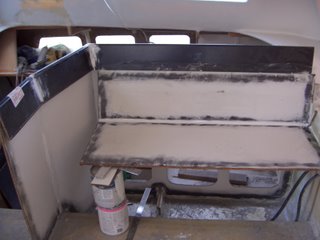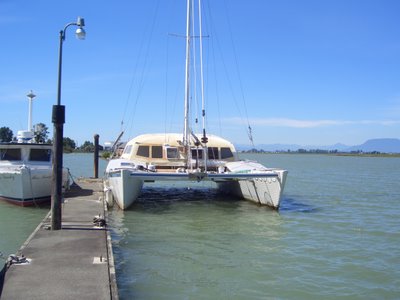The Interior work: Time for an update. It's been 3 weekends of working on the interior (about 25 hours total). I now have a wet locker built, and the settee well underway. The carbon/nomex panels I am using are both a joy and pain to work with.
The pain is the itch and the splinters: carbon fiber dust/shards are worst - worse than fiberglass dust, aluminum shavings in the skin, tiny bits of copper wire. I've had them all in my fingers and carbon hurts the most. There is also a "Tedlar" film coating on a lot of these panels. It's a plastic film that has to be sanded off before bonding anything. It eats sanding discs.
The joy is the results of working with this stuff. To make a rounded corner, you just cut off the inside skin (width depends on the angle you want); fill the exposed core with bog, and fold. It's like magic and makes the most beautfil little rounded corners that would otherwise take hours and hours of fairing to make. It's so stiff that only minimal clamps and jigs are required to hold stuff in place.
Here's a few pictures: The first one is the port settee back (and also the inside of Maia's bookcase which will have openings on the other side of the panel)


Here is a very nice corner that will form the top of the

seat back. Thin enough to grab onto as well. Beautiful isn't it?
The next picture is what I call"the holy grail". I admit it; I'm a wood butcher so real wood cabinetry is beyond me. But this stuff makes it so easy. Here's 3 rounded edges that meet in one corner. Just a tiny bit of bog on the very corner and it will be perfect....
And here's part of the seat in place. You can see the openings for Maia's bookshelf underneath. The above pictures represent 10 hours of work.



























